The Overlooked Environmental Impact of the Entryway
Your entryway says a lot about your home—but it also quietly says a lot about your habits. Shoes, coats, shopping bags, mail, and quick grabs like keys or dog leashes all pass through this high-traffic zone. And while it may feel too small to matter, the entryway can actually influence your household’s entire sustainability footprint.
By examining what lives here—and why—we can uncover a daily pattern of consumption, waste, and environmental opportunity.
The Hidden Story of Shoes and Soles
Toxins That Travel Indoors
Shoes bring in more than just dirt. They can track in:
- Pesticides from lawns
- Oil residue and heavy metals from parking lots
- Microplastics and tire dust from sidewalks and streets
- Fungal spores, bacteria, and viruses from public spaces
These particles get embedded in rugs, floors, and airways, where they linger. If your home has young kids or pets, they’re likely absorbing more than you think.
Sustainable Shoe Habits
- Create a no-shoes policy for indoors (and clearly designate a drop-off zone)
- Use washable or natural fiber rugs at the door to trap debris
- Choose shoes made from recycled, vegan, or biodegradable materials when replacing pairs
- Air out and repair shoes rather than throwing them away after a season
Coats, Gear, and Textile Waste
What’s Hanging by the Door?
Whether it’s jackets, scarves, backpacks, or umbrellas, the entryway is often home to fast fashion. Many quick-buy items meant “just for the season” end up rarely used and poorly made. These synthetic textiles shed microfibers into the air, water, and your laundry routine.
Rethink the Gear Zone
- Invest in long-lasting outerwear made from recycled or organic fabrics
- Donate or repurpose extras that go untouched for a year
- Use non-toxic fabric sprays or sunlight to freshen instead of constant washing
- Label gear (especially kids’ items) to avoid buying duplicates
Mail, Flyers, and Paper Waste
What Lands on Your Table?
Mail piles are an environmental issue hiding in plain sight. Catalogs, flyers, credit offers, and packaging inserts contribute to deforestation, emissions, and landfill buildup—even when recycled.
Tips to Cut Mail Waste
- Opt out of junk mail and catalog lists (DMAchoice.org and CatalogChoice.org)
- Choose paperless billing whenever possible
- Place a paper bin by the entryway for quick, consistent recycling
- Keep a “return/reuse” spot for envelopes, packaging, or reusable mailers
Shopping Bags: Reuse or Overflow?
Plastic, Paper, and Reusables Gone Rogue
Entryways are famous for hoarding tote bags—many of which go unused. Single-use plastic bags still find their way into our lives, while some reusable options are made with high-impact materials that only offset after dozens of uses.
Smarter Bag Habits
- Keep just a few quality, washable tote bags near the door or in your car
- Declutter the rest—donate extras or repurpose them for storage
- Never toss plastic bags in curbside bins unless your town explicitly allows it
- Set up a soft plastics return bin if you shop at stores that collect them
Pet and Kid Gear
Little Habits, Big Impact
If you have pets or kids, your entryway likely includes leashes, treats, toys, sunscreen, bug spray, or wipes. Many of these are single-use or packaged in plastic.
Low-Waste Tips
- Switch to biodegradable poop bags or compostable wipes
- Use refillable containers for treats and snacks
- Try low-tox repellents and mineral-based sunscreens in bulk or stick form
- Donate outgrown gear instead of leaving it in a corner bin
Lighting, Energy, and Airflow
Passive Footprint of the Front Door
Entryway lights, heating/cooling drafts, and motion sensors can quietly burn energy all day and night.
Smart Energy Tips
- Use motion-activated or solar-powered outdoor lights
- Switch to LED bulbs with timers indoors
- Install weather stripping on your door to block air leaks
- Use natural light or windows whenever possible
Final Thoughts: The Doorway to Daily Impact
Your entryway isn’t just a pass-through space—it’s a threshold where habits form. It’s where we dump things we no longer need, store things “just in case,” and often forget what’s even there. But it’s also a place where meaningful change begins.
From your shoes to your shopping bags, your mail to your motion lights—every item is a reminder of what you bring into your home and the world. By making this space more intentional, you set the tone for your entire living environment.
Start here, and the rest of your home will follow.









Reader Interactions